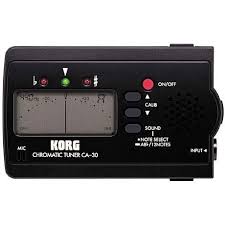I knew how to tune a guitar, but it wasn't until I started taking cello lessons, after I 'd played the cello mostly on my own for a year, that intonation was brought to my attention. My first cello teacher taught me to check as many notes as possible against open strings, which on the cello would be A, D, G, and C. "Checking" means either playing a double stop (e.g., playing a C on the G string with the fourth finger and playing the open C at the same time) or plucking an open string with a left-hand finger while bowing a covered note (e.g., playing the C above middle C on the A string with the third finger and plucking the open C with the first finger). Slightly more sophisticated was checking other perfect intervals -- fourths and fifths (e.g., F with the fourth finger on the G string in fourth position against open C).
Another little trick was checking a covered note with a harmonic. On a stringed instrument, there are points on the string that are natural harmonics; the string only needs to be touched, not pressed down, to sound the note. So for example, if you're playing the A above middle C on the A string, you can lift your finger and merely touch the note to compare your covered A with the harmonic A.
I supposed I surmised from all this that as long as those notes were in tune, everything else would fall in line and was okay. And I do have a pretty good ear, so that was often more or less the case.
A turning point for me was during my second year of graduate school, when I was working on my master's degree. I was preparing for that year's recital, which included Beethoven's A major sonata, Op. 69. This is a particularly tuneful member of the Beethoven cello/piano lineup. In fact, my first teacher introduced it to all of his students fairly early on, though few of us ever played it with piano (I hadn't, until this time I'm describing here). Because it's in A, many of the "important" notes can be checked in the way I was taught by my first teacher. However, it also features rapid scales and other figurations featuring all the other notes in between, and my teacher really got down to brass tacks on this stuff, showing me many more ways to test intonation than I had ever realized were possible. To test an F sharp, for example, she had me check the G above it and the F below it and then place the F sharp between them. Working this way made me aware of intonation in a new way, and I started hearing more acutely whether something was in tune.
Years later, when I was trying to learn the viola, I was finding it very difficult to hear intonation on the higher notes on the A string. I constantly played them sharp. It was during this time that I acquired my first electronic tuner. These are nifty little devices that can be had for about $20, like this one (which is what I have):
They act sort of like biofeedback: you play a note, and the needle veers left if it's flat and right if it's sharp, and there's also a light that shows red if the note is off at all and green and if it matches the frequency setting of the tuner. This particular one can also be calibrated, so you are not stuck with A 440.
It took me a fair amount of time to learn how to use this thing, but it's invaluable to me now. I keep telling people it's better than most teachers. Between this, a metronome, and my recording gadget, I have no excuses!
Until I try to get a piano in tune . . .
To be continued . . .


No comments:
Post a Comment